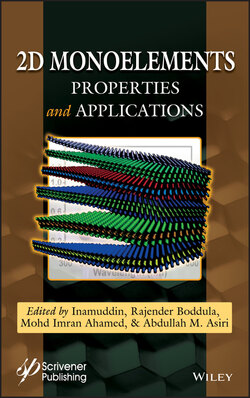Читать книгу 2D Monoelements - Группа авторов - Страница 12
1.1 Introduction
ОглавлениеThe 3D phosphorus is a very abundant element existing in several polymorphous forms. Among the allotropes of phosphorus, namely, white, red, violet, black, and blue; the black one (BP) constitutes the most thermodynamically stable phase under ambient conditions. This layered allotrope was discovered for the first time more than a century ago through the high-pressure [1]. Recently, 3D BP was synthesized from red phosphorus using the new sonochemical method [2]. In bulk BP, the layers are weakly stacked together via VDW interactions [3]. In each layer, the P atoms are connected to their three nearest neighbors by covalent bonds that form a rippled honeycomb structure [4]. BP is a semi-conductor with a direct-gap, a strong in-plane anisotropy and a density greater than 2.5 g/cm3 [5, 6].
Like its counterpart graphene, stable 2D phosphorene can be mechanically extracted from 3D BP. In 2014, phosphorene was synthesized, for the first time, using a scotch tape based microcleavage method [7–9]. The phosphorene’s unit cell is composed of four P atoms and appears highly buckled in the armchair (AC) axis [10]. Because of its geometric characteristics, phosphorene exhibits highly anisotropic physical properties along its AC with respect to its zigzag one [11, 12]. Phosphorene is a p-type semiconductor [13–15] that shows a high flexibility, an important specific capacity and discharge potential that are very required for advanced battery applications [16–18]. In addition, it exhibits a strong excitonic effect [19], an optical gap located at 1.2 eV and its absorbs infrared to near ultraviolet radiation [20]. This new hexagonal material has great potential applications in optoelectronics and photovoltaic devices [21].
Furthermore, the puckered structure of phosphorene attributes its interesting elastic properties such as great structural flexibility and a resistance to 27% and 30% deformations along the zigzag and armchair directions, respectively [22, 23], which makes this material very suitable for wearable optoelectronic devices. Furthermore, the Young’s modulus and Poisson ratio exhibit their maximum values along ZZ-axis indicating how it is difficult to strain it. Consequently, phosphorene is super flexible along the armchair axis [23]. It is also well to mention that phosphorene is an auxetic material [24, 25] and that its non-centrosymmetric point group leads to a large piezoelectric response [23] showing that phosphorene can convert mechanical energy into electrical one [26].
Despite all the exceptional properties of phosphorene, it is very reactive with oxygen due to the non-bonding pairs present at its surface [27]. This fact limits its applications in optoelectronics, sensors, energy conversion, photocatalytic, and so on. To overcome this obstacle, many different techniques have been used to fabricate air-stable phosphorene. The passivated phosphorene by graphene, h-BN, Al2O3, and the polymeric material is a promising technique to avoid chemical debasement and to modulate its features [28]. The measurements shown smaller degradation when phosphorene only exposes to O2 or H2O [29]. Phosphorene with different oxygen concentrations confers excellent new properties in these 2D materials [30, 31]. At high concentration, oxidation leads to a new family, namely, 2D planar and 1D tubular forms, with a transition in the band gap from semiconductors to insulators [32].
In this chapter, we first present pure phosphorene starting from its crystalline structures, its fabrication methods, its physical properties, and ending with certain applications. Secondly, we will investigate how the oxidation’s arrangement and concentrations influence the electronic, elastic, and optical characteristics of phosphorene oxides.
